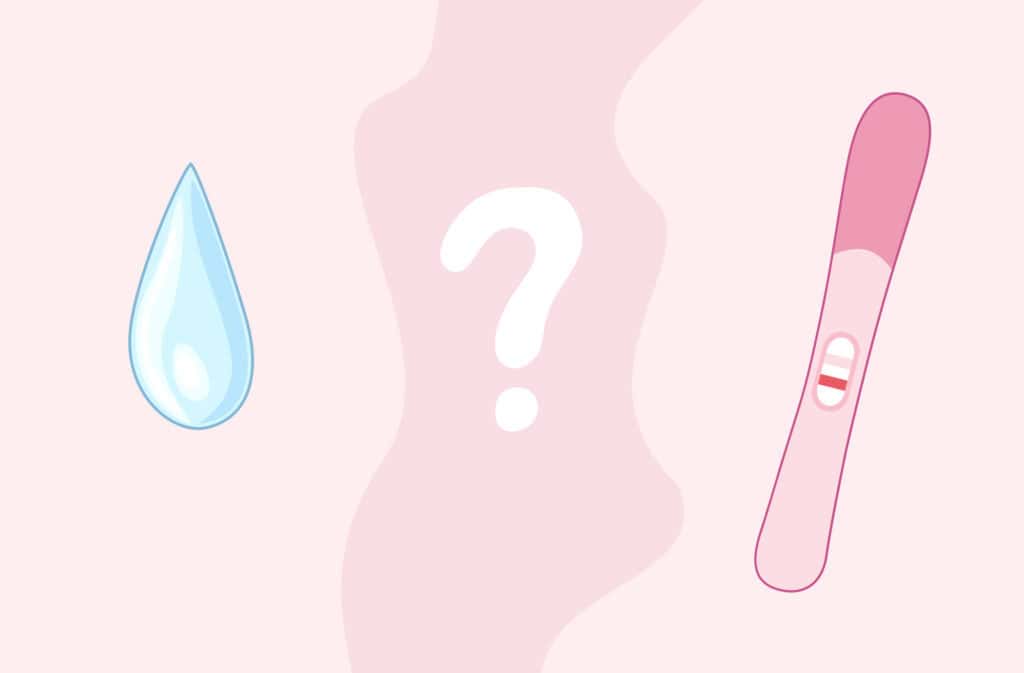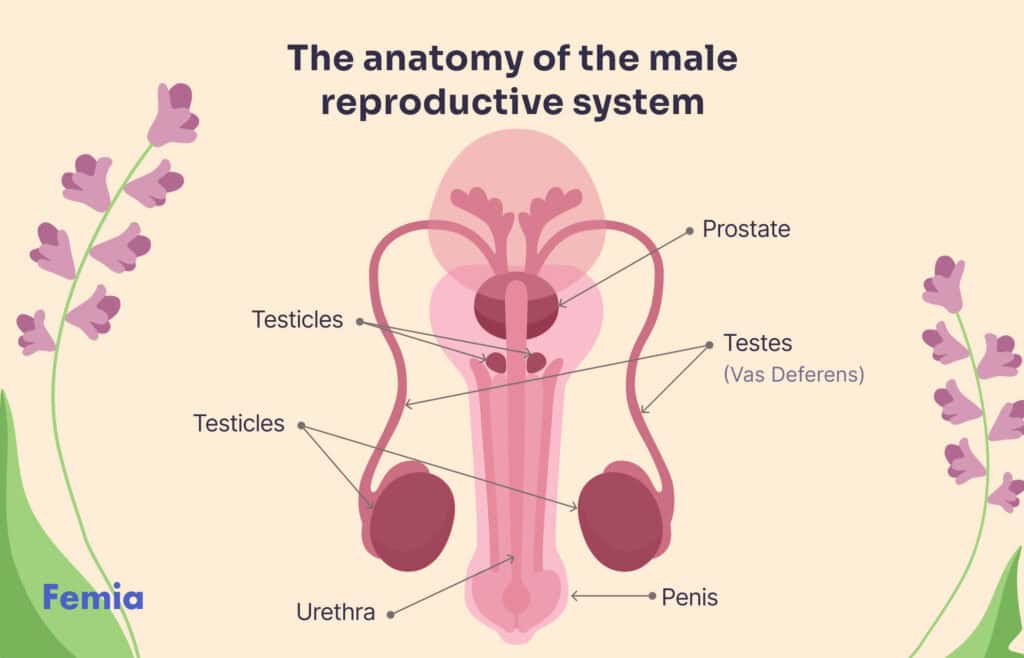Femia > Health Library > Your cycle > Sex > What is precum and can it cause pregnancy? Understanding pre-ejaculatory fluid
What is precum and can it cause pregnancy? Understanding pre-ejaculatory fluid

- Updated Feb 10, 2025
- Published
CRAFTED BY HUMAN
Crafted by human At Femia, we provide accurate and up-to-date information at every stage of your journey, from trying to conceive, pregnancy and postnatal support. All content is created by a real person based on in-depth research and own professional experience. Femia ensures that you will receive expert advice, strict accuracy and a personalized approach from our authors/medical experts. Learn more about our editorial policy.
FACT CHECKED
Fact checked At Femia Health, we maintain the highest standards of editorial excellence in delivering content focused on helping you conceive, guiding you through pregnancy, and supporting you postpartum. Explore our content review principles to learn how we ensure the accuracy and quality of our health and lifestyle tips for every stage of your journey.
Precum, or pre-ejaculate, is a clear fluid released by the penis during sexual arousal. It’s produced by the Cowper’s glands to lubricate the urethra and neutralize acidity, preparing the male body for ejaculation. This fluid is a natural part of the male sexual response and helps facilitate sperm passage during intercourse.
Still, it can sometimes carry sperm left in the urethra from a previous ejaculation. This means that you can get pregnant from precum, although the risk is lower compared to semen.
What is precum, and why does it matter? Precum, also known as pre-ejaculate, is released from your partner’s penis during sex. As the name suggests, it happens before ejaculation, and it is not the same as semen.
Precum carries a small but notable risk of pregnancy. You’ve probably heard that some women get pregnant even when their partner “pulls out“ in time and ejaculates outside of their vagina. How is that possible? Let’s find out together.
It’s important for you to understand what precum is and how it works in order to make informed decisions about your sexual health, contraception, and preventing an unwanted pregnancy.
Femia offers the most accurate tool for determining fertile days
What is precum?
Precum, also known as pre-ejaculate or pre-ejaculatory fluid, is a fluid released from your partner’s penis when sexually aroused.
Why does precum happen? This barely noticeable fluid has a couple of important roles. It reduces friction during sex by lubricating the urethra and the tip of the penis. Thanks to its alkaline nature, it also plays a role in neutralizing any residual acidity left from urine, thus making the urethra a more hospitable environment for sperm to travel.
Where does precum come from?
It may seem like it comes from the same place as semen, but that is not the case. So, where does precum come from? To better understand the origins of precum, we will introduce you to some basic anatomy of the male reproductive system.
The anatomy of the male reproductive system
The penis and testicles are the external organs of the male reproductive system. On the inside, a duct coming from the testes (also known as the Vas Deferens) carries semen all the way up, back, down through the prostate, and then towards the urethra.

The bulbourethral glands, or Cowper’s glands, open into the urethra, close to the prostate. The urethra then carries urine, semen, and precum towards the tip of the penis.
Precum production
Precum is produced by the Cowper’s glands, also known as bulbourethral glands. These are two small, pea-shaped glands located just below the prostate and near the base of the penis.
The Cowper’s glands release precum through the urethra, the tube that carries it out of the body. Despite their size, these glands play a significant role in male sexual and reproductive health.
👉Find out more: Is it safe to have sex while on your period? Everything you need to know
What does precum look like, and what is it made of?
If you’ve never really seen it or paid much attention to it before, you might be wondering: what does precum look like?
Precum is a clear, slippery fluid that has a thinner and more watery consistency compared to semen. It is typically released in small amounts (approximately 4ml) and may not always be noticeable.
We know that you might be concerned about precum and its ability to cause pregnancy. So, what is precum made of? This fluid contains enzymes, mucus, and other natural alkaline substances designed to neutralize the acidity of the urethra.
Naturally, precum contains no sperm, but it might carry traces of it in some cases—we will get to that soon.
When does precum occur?
When does precum occur, exactly? Precum can be released anytime someone is turned on, even if they don’t fully orgasm. For some men, that happens early on during arousal, while for others, it might happen later or just before the ejaculation.
It’s all about how their body responds, and there’s no “normal” when it comes to this. Every time you have sex with your partner, precum might happen at a different time.
What causes precum?
We’ve already explained that precum has several important roles during sex: making the urethra more sperm-friendly and providing natural lubrication to minimize friction. Now, let’s explore what causes precum and how it gets released.
For your partner, precum is a natural part of how they respond to sexual arousal. The Cowper’s glands activate during arousal, producing this clear, slippery fluid to help prepare the body for sexual activity and potential reproduction.
👉Find out more: My husband takes testosterone injections. Can I still get pregnant?
Does precum have sperm?
We’ve finally reached the key question: does precum have sperm? Precum itself typically doesn’t contain sperm, as it’s primarily made up of enzymes and mucus produced by the Cowper’s glands.
However, we mentioned that one canal—the urethra—carries urine, semen, and precum. Therefore, precum can pick up leftover sperm that may still be present in the urethra from a previous ejaculation. This is more likely to happen if your partner hasn’t urinated since the last time they ejaculated, as urination helps flush out any remaining sperm.
This is important when discussing pregnancy risk. While the likelihood of sperm being present in precum is relatively low, it’s not zero. If this fluid comes into contact with your vagina, there is a small chance it could lead to pregnancy. That’s why methods like withdrawal (pulling out) aren’t very reliable.
What is the chance of getting pregnant from precum?
Should you be worried about precum? The chances of pregnancy from precum are definitely lower than with semen. But, it’s still possible if sperm managed to get in there.
Remember, you can get pregnant from precum if you don’t use effective protection, even if you are having sex during your period or right after it. Although the highest chance of getting pregnant still occurs around the time of ovulation (sometimes even if you ovulate in the morning and have sex in the evening), there is no safe time to have sex.
Despite the fact that getting pregnant from precum isn’t common, it’s a risk to be aware of, especially if you are relying on withdrawal as a primary method of contraception.
The withdrawal contraception method
The withdrawal method, often called “pulling out,” requires perfect timing and complete control. This can be a challenge, regardless of how confident your partner appears to be.
Since precum can contain traces of sperm, even before full ejaculation, withdrawal simply isn’t reliable for preventing pregnancy. If you are seeking effective contraception, consider other methods, like condoms or hormonal birth control.
Combining two or more methods can significantly reduce your risk of an unwanted pregnancy, but also various sexually transmitted infections (STIs). Talk to your trusted healthcare provider to find the best combo that works for you.
👉Find out more: Why does it burn after sex? Causes and solutions for discomfort
What is the percentage of precum getting you pregnant?
What is the chance of getting pregnant from precum? The exact percentages are hard to determine due to individual factors like sperm count in the urethra and the timing of intercourse during the menstrual cycle. Still, some experts suggest that sperm in precum could lead to pregnancy in certain circumstances.
According to the International Planned Parenthood Federation, 27% of those who use withdrawal as a regular form of contraception end up pregnant. The risk of pregnancy from precum is generally considered low, but it’s never as low as with effective contraception methods.
What is the difference between precum and cum?
So, let’s compare once again. What is the difference between precum and cum?
| Precum (Pre-ejaculate) | Semen (Ejaculate) | |
|---|---|---|
| Source | Cowper’s glands | Testicles, seminal vesicles, and prostate |
| Main purpose | Lubricates the urethra and neutralizes acidity | Transports sperm for potential fertilization |
| Timing of release | Released when sexually aroused at no specific point | Released during orgasm |
| Appearance | Clear, thin, and slippery | Milky white or grey, thicker, and sticky |
| Sperm content | Usually does not contain sperm but can carry leftover sperm from the urethra | High concentration of sperm |
Precum (pre-ejaculate) is produced by the Cowper’s glands, the small glands located below the prostate. Semen (ejaculate) is created by various inner male reproductive organs, including the testicles, seminal vesicles, and prostate.
The main purpose of precum is to lubricate the urethra and prepare the pathway for sperm. Semen, however, has a reproductive role: it transports sperm to your vagina, womb, and then fallopian tubes for potential fertilization.
Precum can be released at any point during sex. Semen, on the other hand, is only released when your partner has an orgasm, as part of ejaculation.
The appearance is also slightly different. Precum is clear, thin, and slippery, designed for lubrication. Semen is milky white or greyish, thicker, and sticky, designed to carry and protect sperm on its way to your egg.
Precum usually does not contain sperm, but it can pick up any leftovers from the urethra after a previous ejaculation. Semen contains a high concentration of sperm, making it the primary fluid responsible for getting pregnant.
Femia offers the most accurate tool for determining fertile days
Questions from the Femia community
Can I tell if there’s sperm in the precum?
It's not possible to tell if sperm is present in precum just by looking at it. Precum is clear and thin, and its appearance doesn’t change whether it contains sperm or not. To know for sure, you would have to test a sample of your partner’s precum in a lab.
Can I get an STI from precum?
Yes, precum can carry bacteria and viruses, including HIV, which cause various STIs. Microorganisms can be present in the fluid even if ejaculation doesn’t occur; therefore, STIs can be transmitted through any genital fluid exchange. This is why using barrier protection, such as condoms, is essential during sexual activity, even if only precum is released.
The bottom line
Precum, or pre-ejaculate, is a natural fluid released during sex or whenever your man is sexually aroused. It’s nature’s way of preparing his body for intercourse and orgasm.
But, what does precum mean for your sexual health? While its primary role is to lubricate the urethra and neutralize acidity, it can occasionally carry sperm from a previous ejaculation.
This means that pregnancy is possible even if ejaculation doesn’t occur in your vagina. Although the chances are low, it can contribute to conception. You probably understand by now that relying solely on withdrawal for pregnancy prevention might not be fully effective.
Precum can also be a source of STIs, which can only be prevented by barrier methods, like condoms. That’s why it’s important to protect yourself from unwanted pregnancy or STIs and, preferably, use more than one method of contraception. Talk to your partner, and discuss what you can do to make your sexual experience as safe as possible.
References
- Killick, Stephen R., et al. “Sperm Content of Pre-Ejaculatory Fluid.” Human Fertility (Cambridge, England), vol. 14, no. 1, Mar. 2011, pp. 48–52. PubMed Central, https://doi.org/10.3109/14647273.2010.520798.
- “Male Reproductive System.” Cleveland Clinic, https://my.clevelandclinic.org/health/body/9117-male-reproductive-system. Accessed 22 Nov. 2024.
- “What Is Pre-Ejaculatory Fluid (Also Known as Pre-Cum), and Can It Cause Pregnancy? | IPPF.” International Planned Parenthood Federation (IPPF), 13 Feb. 2019, https://www.ippf.org/blogs/what-pre-ejaculatory-fluid-also-known-pre-cum-and-can-it-cause-pregnancy.
- “What Is Semen?” Cleveland Clinic, https://my.clevelandclinic.org/health/body/semen. Accessed 23 Nov. 2024.

Prepare for a healthy pregnancy with our ultimate pre-pregnancy checklist. Learn about essential tests, lifestyle adjustments, financial planning, and more to ensure a smooth journey to parenthood.

Understanding the 4 stages of labor can help you know what to expect when you give birth.

Causes and symptoms of anovulation, a condition where you not ovulating but still have regular menstrual cycles. Discover options to address this common reproductive issue.

